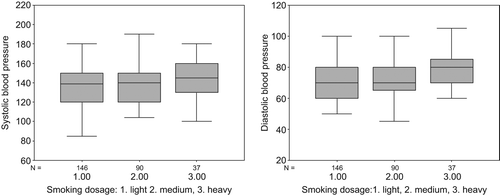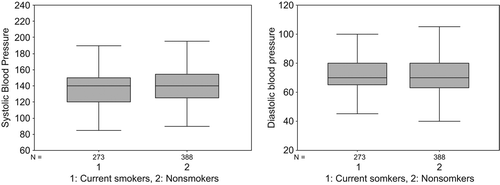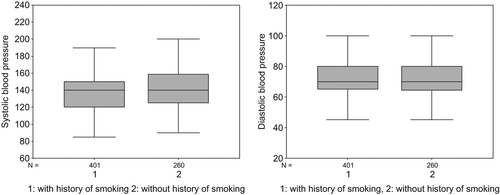Abstract
Objective. Cigarette smoking has been confirmed as a factor influencing arterial blood pressure. In the present study, we studied whether cigarette smoking habits were still associated with arterial blood pressure among Chinese nonagenarians/centenarians. Methods. The present study analyzed data from a survey conducted on all residents aged 90 years or more in the DuJiangYan district (in total 2,311,709 inhabitants) in 2005. Results. The individuals included in the statistical analysis were 216 men and 445 women. Individuals who were heavy smokers (76.62 ± 13.28 mmHg) had higher diastolic blood pressure, compared with medium and light smokers (72.33 ± 12.98 and 70.28 ± 10.31 mmHg) (F = 3.551, p = 0.030). There was a higher prevalence of diastolic hypertension (21.62% vs 5.75% and 7.14%, χ2 = 6.302, p = 0.043). Furthermore, there was a higher risk for diastolic hypertension in heavy smokers (OR = 3.886, 95% CI 1.241–12.161) (adjusted) compared with medium (OR = 1.475, 95% CI 0.599–3.360) and light smokers (1.00 reference). There was, however, no significant difference in systolic blood pressure or prevalence of systolic hypertension among the different smoking groups. Conclusions. In summary, we found that among Chinese nonagenarians/centenarians, heavy smoking (current or former) could increase diastolic blood pressure and prevalence of diastolic hypertension, but was not associated with changes in systolic blood pressure.
Introduction
Cigarette smoking is a strong risk factor for cardiovascular disease (Citation1). Cigarette smoking causes oxidative stress, sympathetic activation and acute vasopressor effects that are associated with hypertension (Citation2,Citation3). Chronic smoking can also cause endothelial abnormity, vascular injury and increased arterial stiffness that may lead to the development of hypertension (Citation4–6). The long-term effect of cigarette smoking on hypertension has not been sufficiently elucidated, and abstinence from smoking is not included in several clinical guidelines for the primary prevention of hypertension (Citation7). A previous population-based study of middle-aged individuals reported that current cigarette smoking was independently risk factor for hypertension (Citation8). However, there also have been some studies that reported lower blood pressure levels among smokers (Citation9) and increases in blood pressure after smoking cessation (Citation10). As a result, it remains unclear to what extent cigarette smoking is a risk factor for the development of hypertension (Citation11). Thus, although many studies find an association of blood pressure with cigarette smoking, many study results are not concordant with each other (Citation12–16). Taken that cigarette smoking affects blood pressure, it needs to be studied whether it may be influenced by factors such as age, gender, race, the time of cigarette smoking and dosage of smoking (Citation12–18). Also, there is currently no study on the association of blood pressure with cigarette smoking in very old subjects. In the present study, using data from a sample of Chinese nonagenarians and centenarians, we examined the association of blood pressure with cigarette smoking in such a population.
Methods
Study participants
The methods of this study have been reported previously (Citation19,Citation20) In brief, as part of the Project of Longevity and Aging in Dujiangyan, a cross-sectional study of age-related diseases was conducted in 870 long-living individuals (> 90 years) on the basis of the Dujiangyan (located in Sichuan province, southwest China) 2005 census. The aims of the Project of Longevity and Aging in Dujiangyan were to investigate the relationship between environment, lifestyle, genetics, longevity and age-related diseases. Participants were examined by trained professional physicians using basic health criteria and age-related diseases were recorded, including cancer, type 2 diabetes, hypertension, heart failure, chronic obstructive pulmonary disease as well as Alzheimer's and Parkinson's diseases. In the current analysis, long-living individuals with cancer, secondary hypertension, severe heart failure and terminal stage of chronic obstructive pulmonary disease were excluded. Individuals where there was no information on smoking habits or on arterial blood pressure were excluded. Our study population ultimately consisted of 661 long-living individuals. Informed consent was obtained from all participants (or their legal proxies). The Research Ethics Committee of the Sichuan University approved the study.
Data collection and measurements
Measurement of blood pressure. Right-arm blood pressure was measured with participants in the sitting or recumbent position by trained nurses or physicians (Citation19). Blood pressure was taken twice, to the nearest 2 mmHg, using a standard mercury sphygmomanometer (Korotkoff phases I and V). The mean value of the two measurements was used to calculate systolic blood pressure and diastolic blood pressure, and the systolic blood pressure and diastolic blood pressure were calculated as the mean of the right- and left-arm values in exceptional cases (upper-extremity vascular disease). The mean of the two readings was used for the classification of blood pressure according to the Joint National Committee VII criteria into normal (systolic blood pressure 120 mmHg and diastolic blood pressure 80 mmHg), pre-hypertension (systolic blood pressure 120–139 mmHg and/or diastolic blood pressure 80–89 mmHg), stage 1 hypertension (systolic blood pressure 140–159 mmHg and/or diastolic blood pressure 90–99 mmHg) or stage 2 hypertension (systolic blood pressure > 160 mmHg and/or diastolic blood pressure > 100 mmHg). Isolated systolic hypertension was defined as systolic blood pressure > 140 mmHg and diastolic blood pressure < 90 mmHg, and isolated diastolic hypertension was defined as systolic blood pressure < 140 mmHg and diastolic blood pressure > 90 mmHg. Hypertension was defined as systolic blood pressure > 140 mmHg and/or diastolic blood pressure > 90 mmHg and/or receiving antihypertensive treatment. Participants with confirmed hypertension and no identified cause of secondary hypertension were diagnosed with essential hypertension. Means ± SD of systolic and diastolic blood pressures are given throughout.
Cigarette smoking. Information on smoking habits was inquired using the questionnaire designed according to the previous study reports (Citation21,Citation22). Participants were classified in the following groups according to the questionnaire: (i) non-smokers: individuals who reported never having smoked a cigarette; (ii) smokers: individuals who reported current smoking with a smoking habit for more than 6 months. For smokers, questions were asked about smoking dose: how many cigarettes were smoked per day? Based on the information, the smokers were grouped as follows: light (1–4 cigarettes per day), medium (5–9 cigarettes per day), heavy (above 10 cigarettes per day). (iii) Individuals with a history of smoking were those individuals who had been smoking for at least 6 months. This group was further classified in those that were former and current smokers. (iv) Finally, the smoking cessation group consisted of those individuals who had quit smoking for at least 6 months. Participants who smoked intermittently (less than 1 cigarette per day) were not included in the study.
Statistical analysis
All statistical analyses in this study were performed with the SPSS for Windows software package, version 11.5 (SPSS Inc, Chicago, IL, USA). Arterial blood pressure levels and prevalence of hypertension were compared between smokers and non-smokers, or among groups with different smoking dosage, or with and without history of smoking, or with and without smoking cessation using χ2 or Fisher's exact test (where an expected cell count was < 5) for categorical variables. One-way analysis of variance and unpaired Student's t-test were used for continuous variables. Multiple logistic regression was used to estimate the odds ratio (OR) and 95% confidence interval (CI) of smoking dosage, current smoking and smoking cessation as a function of increased hypertension. A p-value < 0.05 was considered statistically significant, and all of the p-values have two sides.
Results
Arterial blood pressure and smoking habits among nonagenarians/centenarians
Among the 661 participants, mean age was 93.51 years, 69 were centenarians and 445 were women. Ninety percent of participants lived in the countryside. There were 401 individuals with history of smoking (60.67%), including 128 (19.36%) individuals with smoking cessation and 273 (41.30%) current smokers. In those current smokers 146 (53.48%), 90 (32.97%) and (13.55%) was in the light, medium and heavy dosage groups, respectively. Within the sample, men were more current smokers (64.16% vs 15.96%, χ2 = 87.88, p ≤ 0.001) and also had a longer history of smoking (78.76% vs 50.11%, χ2 = 63.12, p ≤ 0.001) compared with women.
The mean systolic blood pressure and diastolic blood pressure in the population were 140.0 ± 22.9 and 72.0 ± 12.1 mmHg. There were 150 (22.7%) subjects with normal arterial blood pressure, 133 (20.1%) with pre-hypertension, 216 (32.7%) with stage 1 hypertension and 162 (24.5%) with stage 2 hypertension. Of those, there were 364 (55.1%) with systolic hypertension, 86 (13.0%) with diastolic hypertension, 292(44.2%) with isolated systolic hypertension and 14 (2.1%) with isolated diastolic hypertension ().
Table I. Comparison of the age, gender, prevalence of hypertension, systolic hypertension, diastolic hypertension between subjects with smoking and non-smoking habit, and among groups with different smoking dosages (n = 661), using χ2 or Fisher's exact test (aexpected cell count was < 5) for categorical variables, one-way analysis of variance and unpaired Student's t-test for continuous variables.
Heavy current smoking dosages are associated with higher diastolic blood pressure, higher prevalence of diastolic hypertension and higher risk for diastolic hypertension among nonagenarians/centenarians
Individuals who were heavy smokers (76.62 ± 13.28 mmHg) had higher diastolic blood pressure, compared with medium and light smokers (72.33 ± 12.98 and 70.28 ± 10.31 mmHg) (F = 3.551, p = 0.030) (), higher prevalence of diastolic hypertension (21.62% vs 5.75% and 7.14%, χ2 = 6.302, p = 0.043) (). Furthermore, there was a higher risk for diastolic hypertension in heavy smokers (OR = 3.886, 95% CI 1.241–12.161) (adjusted) compared with medium (OR = 1.475, 95% CI 0.599–3.360) and light smokers (1.00, reference) ().
Figure 1. Comparison of the level of arterial blood pressure (including systolic blood pressure (138.01 ± 23.01 vs 137.59 ± 20.26 vs 145.68 ± 25.50, F = 1.890, p = 0.153) and diastolic blood pressure (72.33 ± 12.98 vs 70.28 ± 10.31 vs 76.62 ± 13.28, F = 3.551, p = 0.030) among individuals with different dosages of smoking using one-way analysis of variance.

Table II. Comparison of the age, gender, prevalence of hypertension, systolic hypertension, diastolic hypertension between subjects with history of smoking and non-smoking, and between subjects with different smoking cessation (n = 661), using χ2 or Fisher's exact test (aexpected cell count was < 5) for categorical variables for categorical variables, one-way analysis of variance and unpaired Student's t-test for continuous variables.
Table III. Effect of smoking and smoking cessation on hypertension in long-lived subjects (n = 661).
No association between smoking habits and systolic blood pressure among nonagenarians/centenarians
There was no significant difference in systolic blood pressure or prevalence of systolic hypertension, and no difference in the risk for systolic hypertension among individuals with different smoking dosage, between smokers or non-smokers, between individuals with or without history of smoking or between individuals with and without smoking cessation ( and ).
Figure 2. Comparison of the level of arterial blood pressure (including systolic blood pressure (138.90 ± 22.90 vs 14.65 ± 22.86, t = 0.965, p = 0.335) and diastolic blood pressure (72.23 ± 12.32 vs 72.84 ± 11.88, t = 0.638, p = 0.523) between smokers and non-smokers using unpaired Student's t-test.

Figure 3. Comparison of the level of arterial blood pressure (including systolic blood pressure (138.91 ± 22.90, 138.36 ± 22.51, t = 0.225, p = 0.822) and diastolic blood pressure (72.23 ± 13.32, 72.20 ± 12.20, t = 0.024, p = 0.981) between individuals with and without smoking cessation using unpaired Student's t-test.

Figure 4. Comparison of the level of arterial blood pressure (including systolic blood pressure (138.73 ± 22.75 vs 141.78 ± 22.99, t = 1.675, p = 0.094) and diastolic blood pressure (72.22 ± 12.27 vs 73.15 ± 11.73, t = 0.972, p = 0.331) between individuals with and without history of smoking using unpaired Student's t-test.

Discussion
This study evaluated the effect of smoking habits (including current smoking, smoking history, smoking dosage and smoking cessation) on arterial blood pressure (including systolic blood pressure, diastolic blood pressure, prevalence of systolic hypertension, prevalence of diastolic hypertension or prevalence of hypertension). In the study, we found that current heavy smoking dosage was associated with higher diastolic blood pressure, higher prevalence of diastolic hypertension and higher risk for diastolic hypertension among the long-lived population. There was no association between smoking habits and systolic blood pressure among the nonagenarians/centenarians studied. Further, there was no association between current smoking, smoking cessation or the history of smoking and blood pressure.
To the best of our knowledge, this is the first study on the association of smoking habits and blood pressure among nonagenarians/centenarians. This study in very elderly subjects, revealed an effect on diastolic blood pressure, which is novel since previous studies have shown associations of smoking habits with systolic blood pressure (Citation15–18). With aging, the arterial wall is stiffened and flexibility is reduced and systolic blood pressure is increased (Citation6,Citation7,Citation10).
Our study had some limitations. Firstly, 870 subjects aged 90 years or older volunteered for the PLAD Study, and among these 870 volunteers, only 661 had non-missing data for the two main variables involved in the current analyses. Therefore, there might be selection biases. Secondly, due to the cross-sectional design of this study, we only studied the potential association between smoking habits and blood pressure. Thus, we cannot draw any causal conclusions. Thirdly, since this is a part of the PLAD, there might be a survival bias. However, this is inherent in a study of individuals of this age group. Finally, smoking habits in men were more common than in women. The analysis of cigarette smoking and its potential association with arterial blood should therefore ideally be conducted in respect to gender. However, only 661 subjects were available for analysis, and small numbers might lead to lack of statistical power. This gender aspect could therefore be of importance for the outcome and change the conclusion of the study.
In conclusion, among Chinese nonagenarians/centenarians, heavy smoking habits (former or current) could increase diastolic blood pressure and prevalence of diastolic hypertension, but did not seem to influence systolic blood pressure. Smoking cessation could not remove the effect of heavy smoking on diastolic blood pressure.
Acknowledgements
The authors thank the staff of the Department of Geriatrics Medicine, West China Hospital and Dujiangyan Hospital, and all participants (as well as their legal proxies) for their great contribution.
Conflicts of interest: None.
This work was supported by the Discipline Construction Foundation of Sichuan University, and by grants from the Project of Science and Technology Bureau of Sichuan Province (2006Z09-006-4) and the Construction Fund for Subjects of West China Hospital of Sichuan University (XK05001).
References
- Mannan H, Stevenson C, Peeters A, Walls H, McNeil J. Framingham risk prediction equations for incidence of cardiovascular disease using detailed measures for smoking. Heart Int. 2010;5:e11.
- Barutcu I, Esen AM, Degirmenci B, Acar M, Kaya D, Turkmen M, et al. Acute cigarette smoking induced hemodynamic alterations in the common carotid artery. Circ J. 2004;68:1127–1131.
- Sesso HD, Buring JE, Rifai N, Blake GJ, Gaziano JM, Ridker PM. C-reactive protein and the risk of developing hypertension. JAMA. 2003;290:2945–2951.
- Li H, Srinivasan SR, Chen W, Xu J, Li S, Berenson GS. Vascular abnormalities in asymptomatic, healthy young adult smokers without other major cardiovascular risk factors: The Bogalusa Heart Study. Am J Hypertens. 2005;18:319–324.
- Kim JW, Park CG, Hong SJ, Park SM, Rha SW, Seo HS, et al. Acute and chronic effects of cigarette smoking on arterial stiffness. Blood Press. 2005;12:80–85.
- Oparil S, Zaman A, Calhoun DA. Pathogenesis of hypertension. Ann Intern Med. 2003;139:761–776.
- Whelton PK, He J, Appel LJ, Cutler JA, Havas S, Kotchen TA, et al. Primary prevention of hypertension. JAMA. 2002;288:1882–1888.
- Niskanen L, Laaksonen DE, Nyyssönen K, Punnonen K, Valkonen VP, Fuentes R, et al. Inflammation, abdominal obesity, and smoking as predictors of hypertension. Hypertension. 2004;44:859–865.
- Green MS, Jucha E, Lz Y. Blood pressure in smokers and non-smokers: Epidemiologic findings. Am Heart J. 1986; 111:932–940.
- Lee D, Ha M, Kim J, Jacobs DR. Effects of smoking cessation on changes in blood pressure and incidence of hypertension. Hypertension. 2001;37:194–198.
- Green MS, Jucha E, Luz Y. Blood pressure in smokers and nonsmokers: Epidemiologic findings. Am Heart J. 1986; 111:932–940.
- Mikkelsen KL, Wiinberg N, Hoegholm A. Christensen HR, Bang LE, Nielsen PE, et al. Smoking related to 24-h ambulatory blood pressure and heart rate: A study in 352 normotensive Danish subjects.. Am J Hypertens. 1997;10:483–491.
- Lee DH, Ha MH, Kim JR, Jacobs DR, Jr. Effects of smoking cessation on changes in blood pressure and incidence of hypertension: A 4-year follow-up study. Hypertension. 2001;37:194–198.
- Okubo Y, Suwazono Y, Kobayashi E, Nogawa K. An association between smoking habits and blood pressure in normotensive Japanese men: A 5-year follight-up study. Drug Alcohol Depend. 2004;73:167–174.
- Omvik P. How smoking affects blood pressure. Blood Press. 1996;5:71–77.
- Narnkiewicz K, Kjeldsen SE, Hedner T. Is smoking a causative factor of hypertension?. Blood Press. 2005;14:69–71.
- Fogari R, Zoppi A, Lusardi P, Marasi G, Villa G, Vanasia A. Cigarette smoking and blood pressure in a worker population: A cross-sectional study. J Cardiovasc Risk. 1996;3:55–59.
- Primatesta P, Falaschetti E, Gupta S, Marmot MG, Poulter NR. Association between smoking and blood pressure: Evidence from the health survey for England. Hypertension. 2001;37:187–193.
- Yan Z, Bi-Rong D, Hui W, Chang-Quan H. Serum lipid/ lipoprotein and arterial blood pressure among Chinese nonagenarians/centenarians. Blood Press. 2011;20:296–302.
- Ji-Rong Y, Hui W, Chang-Quan H, Bi-Rong D. Association between sleep quality and arterial blood pressure among Chinese nonagenarians/centenarians. Med Sci Monit. 2012; 18:36–42.
- Juan D, Zhou DH, Li J, Wang JY, Gao C, Chen M. A 2-year follow-up study of cigarette smoking and risk of dementia. Eur J Neurol. 2004;11:277–282.
- Tyas SL, White LR, Petrovitch H, Webster Ross G, Foley DJ, Heimovitz HK, et al. Mid-life smoking and late life dementia: The Honolulu-Asia Aging Study. Neurobiol Aging. 2003; 24:589–596.
